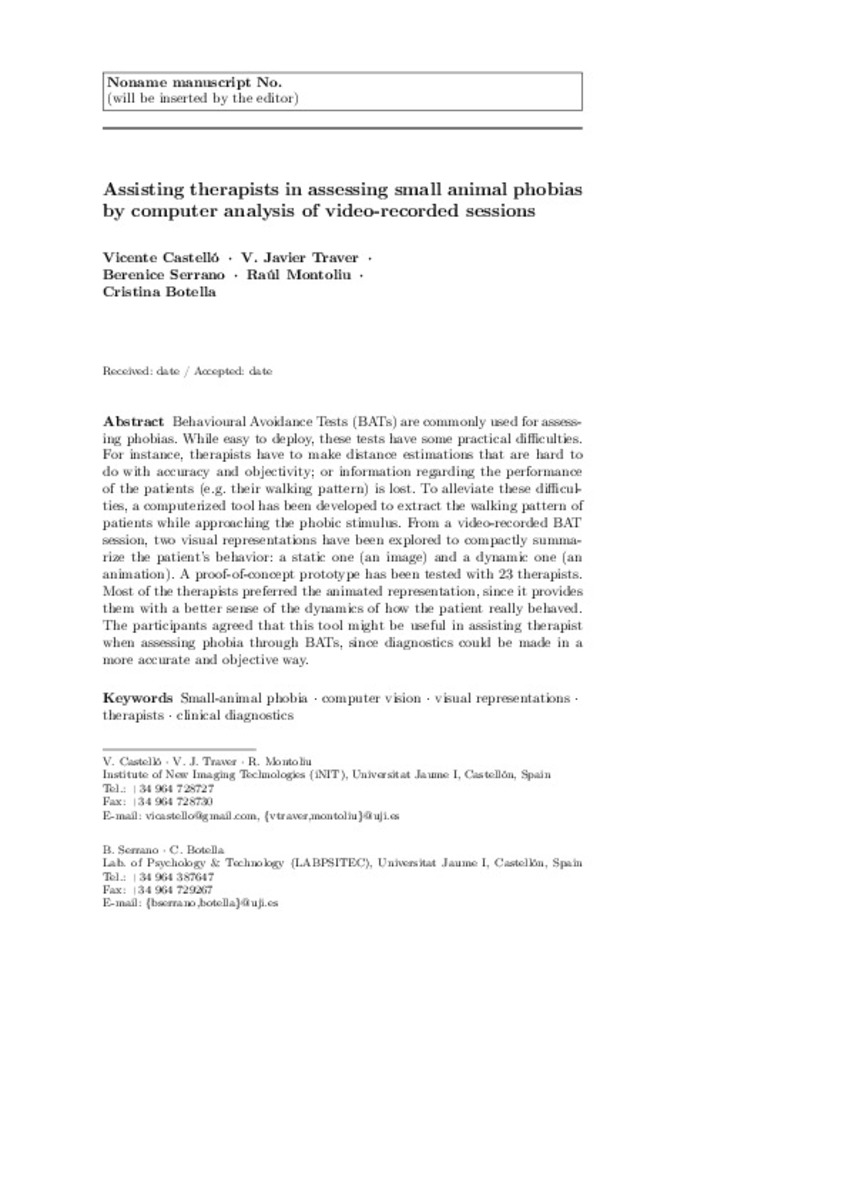Mostrar el registro sencillo del ítem
Assisting therapists in assessing small animal phobias by computer analysis of video-recorded sessions
| dc.contributor.author | Castelló, Vicente | |
| dc.contributor.author | Traver Roig, Vicente Javier | |
| dc.contributor.author | Serrano-Zárate, Berenice | |
| dc.contributor.author | Montoliu Colás, Raul | |
| dc.contributor.author | Botella, Cristina | |
| dc.date.accessioned | 2016-12-14T12:05:15Z | |
| dc.date.available | 2016-12-14T12:05:15Z | |
| dc.date.issued | 2017 | |
| dc.identifier.citation | Castelló, V., Traver, V.J., Serrano, B. et al. Multimed Tools Appl (2017) 76: 21033. https://doi.org/10.1007/s11042-016-3997-7 | ca_CA |
| dc.identifier.uri | http://hdl.handle.net/10234/165044 | |
| dc.description.abstract | Behavioural Avoidance Tests (BATs) are commonly used for assessing phobias. While easy to deploy, these tests have some practical difficulties. For instance, therapists have to make distance estimations that are hard to do with accuracy and objectivity; or information regarding the performance of the patients (e.g. their walking pattern) is lost. To alleviate these difficulties, a computerized tool has been developed to extract the walking pattern of patients while approaching the phobic stimulus. From a video-recorded BAT session, two visual representations have been explored to compactly summarize the patient’s behavior: a static one (an image) and a dynamic one (an animation). A proof-of-concept prototype has been tested with 23 therapists. Most of the therapists preferred the animated representation, since it provides them with a better sense of the dynamics of how the patient really behaved. The participants agreed that this tool might be useful in assisting therapist when assessing phobia through BATs, since diagnostics could be made in a more accurate and objective way. | ca_CA |
| dc.description.sponsorShip | This work has been partly supported by Fundació Caixa-Castelló (through grant P1-1A2010-11) and Generalitat Valenciana (through grant PROMETEOII2014062). | ca_CA |
| dc.format.extent | 17 p. | ca_CA |
| dc.format.mimetype | application/pdf | ca_CA |
| dc.language.iso | eng | ca_CA |
| dc.publisher | Springer | ca_CA |
| dc.relation.isPartOf | Multimed Tools Appl (2017) 76 | ca_CA |
| dc.rights | © 2016 Springer International Publishing AG. Part of Springer Nature. | ca_CA |
| dc.rights.uri | http://rightsstatements.org/vocab/InC/1.0/ | * |
| dc.subject | Small-animal phobia | ca_CA |
| dc.subject | Computer vision | ca_CA |
| dc.subject | Visual representations | ca_CA |
| dc.subject | Therapists | ca_CA |
| dc.subject | Clinical diagnostics | ca_CA |
| dc.title | Assisting therapists in assessing small animal phobias by computer analysis of video-recorded sessions | ca_CA |
| dc.type | info:eu-repo/semantics/article | ca_CA |
| dc.identifier.doi | http://dx.doi.org/10.1007/s11042-016-3997-7 | |
| dc.rights.accessRights | info:eu-repo/semantics/openAccess | ca_CA |
| dc.relation.publisherVersion | http://link.springer.com/article/10.1007/s11042-016-3997-7 | ca_CA |
| dc.date.embargoEndDate | 2018-11-01 | |
| dc.type.version | info:eu-repo/semantics/acceptedVersion | ca_CA |
Ficheros en el ítem
Este ítem aparece en la(s) siguiente(s) colección(ones)
-
INIT_Articles [748]
-
ICC_Articles [418]
-
LSI_Articles [362]
Articles de publicacions periòdiques escrits per professors del Departament de Llenguatges i Sistemes Informàtics -
PSB_Articles [1310]
Articles de publicacions periòdiques







